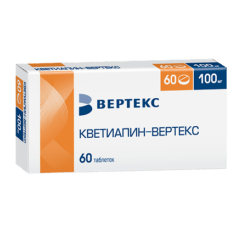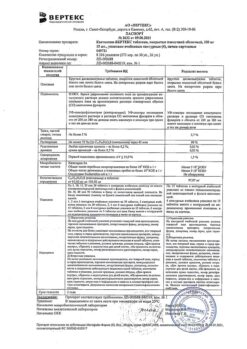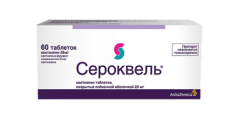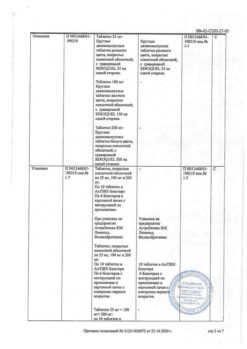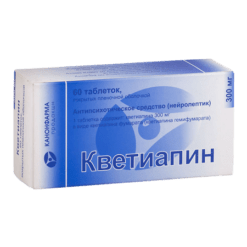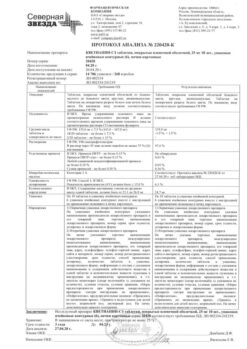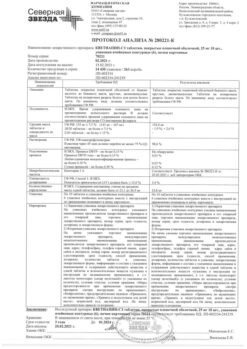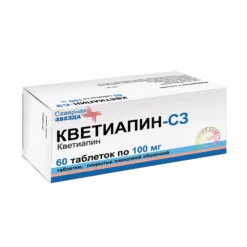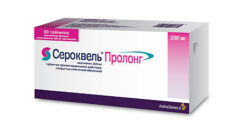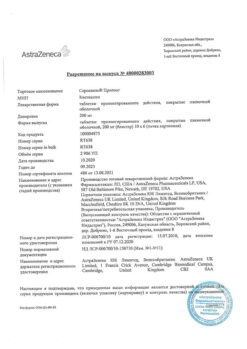No products in the cart.
Quetiapine 100 mg, 60 pcs.
€1.00
Out of stock
(E-mail when Stock is available)
Description
- Treatment of acute and chronic psychosis, including schizophrenia.
- Treatment of manic episodes in the structure of bipolar disorder. Treatment of depressive episodes of moderate to severe severity in bipolar disorder.
- The drug is not indicated for prevention of manic and depressive episodes.
.
Active ingredient
Active ingredient
How to take, the dosage
How to take, the dosage
Interaction
Interaction
Special Instructions
Special Instructions
Contraindications
Contraindications
Side effects
Side effects
The most common side effects of quetiapine (>10%) are drowsiness, dizziness, dry mouth, withdrawal syndrome, increased triglyceride concentration, increased total cholesterol concentration (mainly low-density lipoprotein cholesterol – LDL), decreased high-density lipoprotein cholesterol concentration (HDL), increased body weight, decreased hemoglobin concentration and extrapyramidal symptoms.
Very common (>1/10)
/td>
Anxiety of the central nervous system:
Dizziness1,4,17, drowsiness2,17, headache, extrapyramidal symptoms1,13
Gastrointestinal tract side:
Mouth dryness
General disorders:
Withdrawal syndrome1,10
Lab and instrumental changes:
Elevated triglyceride concentration1,11, total cholesterol (mainly LDL cholesterol)1,12, decreased HDL cholesterol concentration1,18, increased body weight9, decreased hemoglobin concentration23
/p>
Often (>1/100, <1/10)
On the side of the hematopoietic system:
Leukopenia1.25
From the central nervous system:
Dysarthria, unusual and nightmarish dreams, increased appetite
Cardiovascular system side:
Tachycardia1,4, palpitations19, orthostatic hypotension1,4,17
Visual side:
Blurred vision
Respiratory system side:
Dyspnea19
Gastrointestinal tract side:
Constipation, dyspepsia, vomiting21
General disorders:
Slightly pronounced asthenia, irritability, peripheral edema, fever
Changes in laboratory and instrumental parameters:
Increased ALT3 activity, increased GGT3 activity, decreased neutrophil count1,22, increased eosinophil count24, hyperglycemia1,7, increased serum prolactin concentration16, decreased total and free T420 concentration, decreased
concentration of total T320, increased concentration of TTH20
Infrequent (>1/1000, <1/100)
Cardiovascular system side:
Bradycardia26
Immune system side:
Hypersensitivity reaction
On the side of the central nervous system:
Convulsions1, restless legs syndrome,
tardive dyskinesia1, syncope1,4,17
Respiratory system side:
Rhinitis
Gastrointestinal tract side:
Dysphagia1.8
Kidney and urinary tract side:
Urinary retention
Changes in laboratory and instrumental parameters:
Increased ACT3 activity , thrombocytopenia4, prolongation of QT1,13 interval, decreased free T320 concentration
Rare (>1/10000, <1/1000)
Liver and biliary tract side:
Jaundice6
Reproductive system side:
Priapism, galactorrhea
General disorders:
Malignant neuroleptic syndrome1, hypothermia
Changes in laboratory and instrumental parameters:
Increased creatine phosphokinase activity15 , agranulocytosis27
Anxiety of the central nervous system:
Somnambulism and similar phenomena
Gastrointestinal side:
Intestinal obstruction/ileus
Very rare (<1/10000)
Immune system disorders:
Anaphylactic reactions6
Metabolic disorders:
Diabetes mellitus1,5,6
Liver and biliary tract side:
Hepatitis (with or without jaundice)6
Skin and subcutaneous tissue:
Angioneurotic edema6, Stevens-Johnson syndrome6
Unspecified frequency
Hematopoietic disorders:
Neutropenia1
General disorders:
Withdrawal syndrome in neonates
1. See “Special Precautions”
2. Sleepiness usually occurs within the first 2 weeks of starting therapy and usually resolves with continued quetiapine administration.
3. serum aspartate aminotransferase (ACT), alanine aminotransferase (ALT) and gamma-glutamyl transpeptidase (GGT) activity may be asymptomatic (>3 times the upper limit of normal when measured at any time), usually reversible with continued quetiapine administration.
4 Like other antipsychotics with α1-adrenoblocking effects, quetiapine often causes orthostatic hypotension, which is accompanied by dizziness, tachycardia, and in some cases, fainting, especially at the beginning of therapy.
5. very rare cases of decompensation of diabetes mellitus have been reported.
6. The frequency of this side effect was evaluated on the basis of post-marketing surveillance.
7. Elevated fasting blood glucose concentration > 126 mg/dL (> 7.0 mmol/L) or post-meal blood glucose > 200 mg/dL (> 11.1 mmol/L) at least once determined.
8. A higher incidence of dysphagia on quetiapine compared with placebo was noted only in patients with depression within the structure of bipolar disorder.
9. an increase in initial body weight of at least 7%. Mostly occurs at the beginning of therapy in adults
10. In a study of withdrawal symptoms in short-term placebo-controlled clinical trials of quetiapine monotherapy, the following symptoms were noted: insomnia, nausea, headache, diarrhea, vomiting, dizziness, and irritability. The frequency of “withdrawal” syndrome was significantly reduced 1 week after discontinuation of the drug.
11. Elevated triglyceride concentration >200 mg/dL (>2.258 mmol/L) in patients >18 years or >150 mg/dL (>1.694 mmol/L) in patients <18 years, at least at a single determination.
12. Elevation of total cholesterol > 240 mg/dL (> 6.2064 mmol/L) in patients >18 years old or > 200 mg/dL (> 5.172 mmol/L) in patients <18 years old, at least at a single determination.
13. See later in the text of the Instructions.
14. Decreased platelet count < 100 x 109/L, at least at a single determination.
15. Without association with malignant neuroleptic syndrome. According to clinical studies.
16. Elevated prolactin concentration in patients >18 years: >20 µg/L (>869.56 pmol/L) in men; >30 µg/L (>1304.34 pmol/L) in women.
17. May lead to falls.
18. Decreased HDL cholesterol concentration < 40 mg/dL (< 1.03 mmol/L) in men and < 50 mg/dL (< 1.29 mmol/L) in women.
19. These phenomena were often noted with a background of tachycardia, dizziness, orthostatic hypotension and/or concomitant cardiovascular or respiratory pathology.
20. Based on potentially clinically significant deviations from normal baseline noted in all clinical studies. Changes in total T4, free T4, total T3, free T3 concentration to values < 80% of the lower limit of normal (pmol/L) when measured at any time. Change in TTH concentration > 5 mMED/L when measured at any time.
21. Based on increased incidence of vomiting in elderly patients (age > 65 years).
22. In short-term clinical trials of quetiapine monotherapy in patients with pre-therapy neutrophil counts >1.5 x 109/L, cases of neutropenia (neutrophil count <1.5 x 109/L) were reported in 1.9% of patients in the quetiapine group versus 1.5% in the placebo group. Reduced neutrophil counts >0.5 but <1.0 x 109 /l were noted at a rate of 0.2% in the quetiapine and placebo groups. A decrease in neutrophil count <0.5 x 109/L at least once was noted in 0.21% of patients in the quetiapine group versus 0% in the placebo group.
23. Decreases in hemoglobin concentration <13 g/dL in men and <12 g/dL in women, at least at a single determination were noted in 11% of patients on quetiapine in all clinical trials, including long-term therapy. In short-term placebo-controlled trials, decreases in hemoglobin concentration <13 g/dL in men and <12 g/dL in women, at least at a single determination, were noted in 8.3% of patients in the quetiapine group compared with 6.2% in the placebo group.
24. Based on potentially clinically significant deviations from baseline normal levels noted in all clinical trials. Increased eosinophil count > 1 x 109/L when measured at any time.
25. Based on potentially clinically significant deviations from baseline normal levels noted in all clinical studies. Decreased white blood cell count <3 x 109/L when measured at any time.
26. May develop at or shortly after initiation of therapy and be accompanied by hypotension and/or syncope. Frequency is established on the basis of reports of bradycardia and related adverse events in all clinical trials of quetiapine.
27 Based on frequency estimate in patients who participated in all clinical trials of quetiapine who had severe neutropenia (< 0.5 x 109/L) in association with infections.
28. See “Pregnancy and Breastfeeding Period”.
Long QT interval, ventricular arrhythmias, sudden death, cardiac arrest, and bidirectional ventricular tachycardia are considered to be side effects inherent to neuroleptics. The incidence of EPS in short-term clinical trials in adult patients with schizophrenia and mania within bipolar disorder was comparable in the quetiapine and placebo groups (patients with schizophrenia: 7.8% in the quetiapine group and 8.0% in the placebo group; mania within bipolar disorder: 11.2% in the quetiapine group and 11.4% in the placebo group).
The incidence of EPS in short-term clinical trials in adult patients with depression within the structure of bipolar disorder was 8.9% in the quetiapine group and 3.8% in the placebo group. At the same time, the frequency of individual symptoms of EPS (such as akathisia, extrapyramidal disorders, tremor, dyskinesia, dystonia, anxiety, involuntary muscle contractions, psychomotor agitation, and muscle rigidity) was generally low and did not exceed 4% in each treatment group. In long-term clinical trials of quetiapine in schizophrenia and bipolar disorder in adult patients, the incidence of EPS was comparable in the quetiapine and placebo groups.
A dose-dependent decrease in thyroid hormone concentrations may be observed during quetiapine therapy. The frequency of potentially clinically significant changes in thyroid hormone concentrations in short-term clinical studies for total T4 was 3.4% in the quetiapine group and 0.6% in the placebo group; for free T4, 0.7% in the quetiapine group versus 0.1% in the placebo group; for total T3, 0.54% in the quetiapine group versus 0.0% in the placebo group; for free T3, 0.2% in the quetiapine group versus 0.0% in the placebo group.
A change in TTH concentration was noted with a frequency of 3.2% in the quetiapine group and 2.7% in the placebo group. In short-term clinical trials of monotherapy, the frequency of potentially clinically significant changes in T3 and TTH concentrations was 0.0% in the quetiapine and placebo groups; for T4 and TTH, it was 0.1% in the quetiapine group versus 0.0% in the placebo group. These changes were generally not associated with clinically significant hypothyroidism. The maximum decrease of total and free T4 was registered at the 6th week of quetiapine therapy, with no further decrease of hormone concentrations during long-term treatment. In almost all cases, the concentration of total and free T4 returned to the initial level after discontinuation of quetiapine therapy, regardless of the duration of treatment. The concentration of thyroxine-binding globulin (TSH) remained unchanged when measured in 8 patients.
Overdose
Overdose
Similarities
Similarities
Additional information
| Shelf life | 3 years. |
|---|---|
| Conditions of storage | In the dark place at a temperature not exceeding 25 °С. Store out of the reach of children. |
| Manufacturer | Drug Technology, Russia |
| Medication form | pills |
| Brand | Drug Technology |
Other forms…
Related products
Buy Quetiapine 100 mg, 60 pcs. with delivery to USA, UK, Europe and over 120 other countries.


